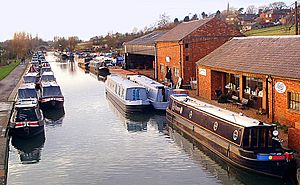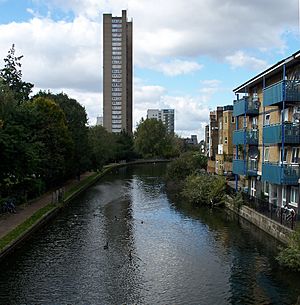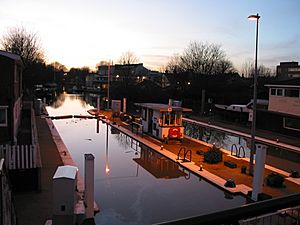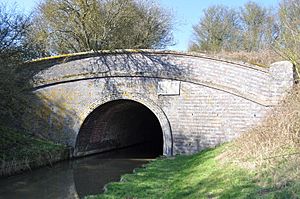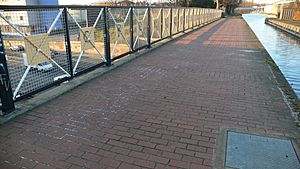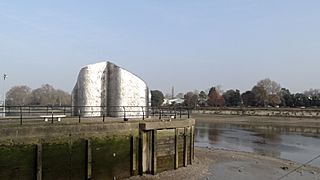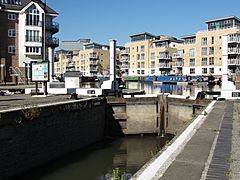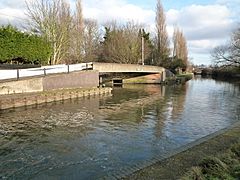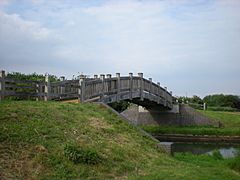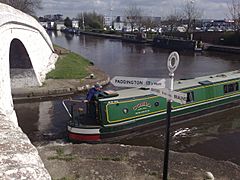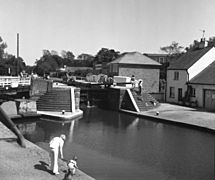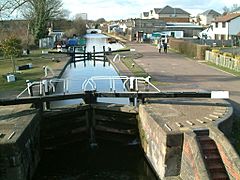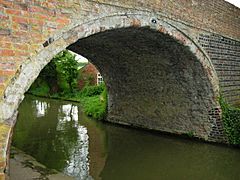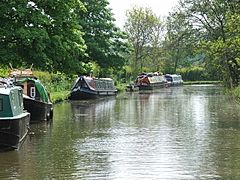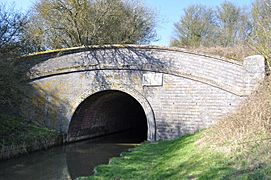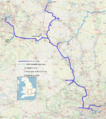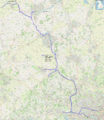Grand Union Canal facts for kids
The Grand Union Canal is a really long and important waterway in England. It's part of the amazing British canal system. Imagine a giant water road that starts in London and goes all the way to Birmingham! This main route is about 137 miles (220 km) long and has 166 special water elevators called locks.
The Grand Union Canal also has smaller branches, like arms, that reach out to other places. These include Leicester, Slough, Aylesbury, Wendover, and Northampton.
You might hear about an "Old Grand Union Canal". This was the original name for a part of what is now called the Leicester Line of the modern canal. We call it "Old" to avoid confusion!
Contents
How the Grand Union Canal Was Built
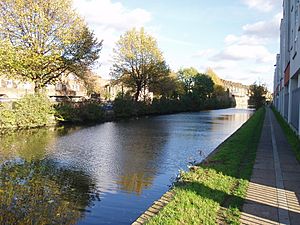
In the late 1800s and early 1900s, canals faced tough competition. First, trains took a lot of their business. Then, new roads and trucks started taking even more! To stay in business, the companies that owned the canals decided to team up and make their waterways better.
On January 1, 1929, many smaller canals joined together to form the Grand Union Canal we know today. It grew even more in 1932. This made it the longest "merged" canal in the UK, stretching about 286.3 miles (460.8 km)!
Joining Different Canals
Many canals became part of the Grand Union:
- The Regent's Canal
- The Hertford Union Canal (bought by Regent's Canal in 1857)
For the main route:
- The Warwick and Napton Canal
- The Warwick and Birmingham Canal
- The Birmingham and Warwick Junction Canal
- The Grand Junction Canal
(All these were bought by the Regent's Canal company in 1927.)
For the Leicester Line:
(Both bought by the Grand Junction in 1894.)
- The Leicester Navigation
- The Loughborough Navigation
- The Erewash Canal
(These were bought by the Grand Union in 1932.)
A small part of the Oxford Canal (about 5 miles (8.0 km)) is also used by the Grand Union between Braunston and Napton.
Making the Canal Wider
The section of the canal from Brentford to Braunston was built as a "wide" canal. This meant its locks were big enough for two narrowboats side-by-side, or one wide boat up to 14 feet (4.3 m) across.
However, the sections from Braunston to Birmingham were "narrow" canals. Their locks could only fit one narrowboat at a time. In 1931, a special law was passed to make these narrow locks wider. This project was helped by government money.
The narrow locks and some bridges between Napton and Birmingham were rebuilt. They could then fit wide boats up to 12 feet 6 inches (3.81 m) across, or two narrowboats. The canal bed was also made deeper (to 5 feet 6 inches (1.68 m)) and wider (to 26 feet (7.9 m)). This allowed bigger boats to carry more goods. The new wide locks at Hatton were opened in 1934.
Even with these improvements, wide boats never became very popular. The canal mostly continued to be used by pairs of narrowboats.
The three sections of the 'Leicester line' (from Norton junction to the River Trent) have mixed sizes. Some parts are narrow, and some are wide. There were plans to widen the locks at Watford and Foxton, but the money for this never came through.
Canal Changes Over Time
In 1948, the Grand Union Canal became owned by the government. Commercial boat traffic slowly stopped in the 1970s. However, people started using the canal for fun, like boating, fishing, and walking along the towpath. Today, the canal is as busy as ever with leisure activities! Recently, some cargo traffic has even returned, carrying materials like aggregates.
Exploring the Canal: Brentford to Braunston
The Grand Union Canal starts in west London at Brentford, where it meets the River Thames. The Thames Lock (lock number 101) separates the canal from the tidal River Thames. For about 3 miles (4.8 km) upstream, the canal and the Brent river are the same waterway.
After passing through a few locks, the canal heads west through areas like Southall, Hayes, and Yiewsley.
Key Junctions and Features
- Bulls Bridge Junction: About 3 miles (4.8 km) from Norwood, this was once a major dockyard. Here, the Paddington Arm branches off to the north. It runs for 12 miles (19 km) to join the Regents Canal at a beautiful spot called Little Venice.
- Cowley Peachey Junction: Just before Uxbridge, the Slough Arm branches off to the west.
- Climbing the Chiltern Hills: As the canal goes past Rickmansworth and Kings Langley, it starts to climb into the Chiltern Hills. There are many locks here, including the "New 'Uns" at Kings Langley, which replaced older locks in 1819.
- Tring Summit: At Cow Roast Lock, the canal reaches its highest point, called the Tring summit. It has climbed through 54 locks since Brentford!
- Marsworth and Aylesbury Arms: At the north-west end of the summit, the Marsworth flight of seven locks begins the descent. Here, the Wendover Arm branches off westwards. A bit further down, the Aylesbury Arm branches off to the south-west.
- Milton Keynes: The canal then crosses a wide valley, passing through villages like Cheddington and Leighton Buzzard. It enters Milton Keynes at Fenny Stratford Lock. In Milton Keynes, it crosses the modern New Bradwell Aqueduct and then the "Iron Trunk" aqueduct over the Great Ouse at Cosgrove.
- Stoke Bruerne and Blisworth Tunnel: After rising through Cosgrove Lock, the canal reaches the Stoke Bruerne flight of seven locks. At the top is the Stoke Bruerne Canal Museum. Soon after, you enter the Blisworth Tunnel, one of the longest canal tunnels in the UK at 3,056 yards (2,794 m).
- Northampton Arm: After the tunnel, the canal reaches Gayton Junction, where the Northampton Arm branches off to the east. This arm has 17 narrow locks and connects to the River Nene.
- Braunston Summit: The canal continues through rural areas past villages like Nether Heyford and Weedon Bec. At Whilton, the Buckby flight of seven locks raises the canal to the Braunston summit.
- Braunston Tunnel: Beyond the top lock, the Leicester line branches off north at Norton Junction. A few miles further, the canal goes through the 2,040 yards (1,870 m) Braunston Tunnel.
- Braunston Junction: Finally, the canal drops down the Braunston flight of six locks to reach Braunston Junction, having traveled over 93 miles (150 km).
The Birmingham Main Line
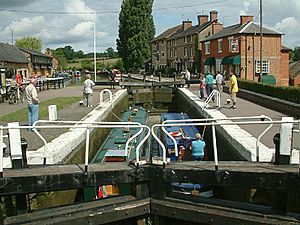
At Braunston Junction, the Oxford Canal splits off. The Grand Union Canal heads north towards Birmingham.
Journey to Birmingham
- Napton Junction: Shortly after Braunston, the Grand Union and Oxford canals share a 5 miles (8.0 km) section to Napton Junction. Here, the Grand Union turns north towards Birmingham.
- Descent to River Avon: The canal then descends through three locks at Calcutt. After a 3 miles (4.8 km) level section, it drops into the River Avon valley using the Stockton flight of 10 locks.
- Leamington Spa and Warwick: A 3 miles (4.8 km) level section leads to the four Bascote locks. Then, a 5 miles (8.0 km) level takes the canal through Leamington Spa to Warwick. In Warwick, the canal rises by two locks to Budbrooke Junction.
- Saltisford Canal Arm: At Warwick, you can find the restored Saltisford Canal Arm. This short branch used to be the main line of the Warwick and Birmingham Canal and served the town's wharfs.
- Hatton Flight: After half a mile, the main line reaches the bottom of the Hatton flight of 21 locks. These locks lift the canal high up out of the Avon Valley.
- Shrewley Tunnel and Knowle Locks: About 3 miles (4.8 km) from Hatton Top Lock, the canal goes through Shrewley Tunnel. Then, it passes Rowington village and reaches Kingswood Junction, where a short path connects to the Stratford-upon-Avon Canal. Another 3 miles (4.8 km) leads to the Knowle flight of five locks.
- Into Birmingham: Finally, an 11 miles (18 km) level section takes the canal through areas like Elmdon Heath, Solihull, and Tyseley, right into the heart of Birmingham.
The main line of the Grand Union Canal ends at Bordesley Junction. From here, you can take two routes: one leads to the Digbeth Branch Canal and the other to the Birmingham and Fazeley Canal, which connects to other major canals.
The Leicester Line
The 'Leicester Line' of the Grand Union Canal goes north from Norton Junction for about 35 miles (56 km) until it reaches Leicester. There, it joins the River Soar to connect to the River Trent and the Trent and Mersey Canal.
Features of the Leicester Line
- Tunnels: This line includes tunnels south of Crick (1,528 yards (1,397 m)) and north of Husbands Bosworth (1,166 yards (1,066 m)).
- Crick Boat Show: The village of Crick is famous for its popular annual boat show.
- Leicester's Mile Straight: The part of the canal that goes through the center of Leicester is called the 'Mile Straight'. It's used by the Leicester Rowing Club for rowing and sculling.
- Foxton and Watford Locks: This section also has the famous Foxton Locks and Watford Locks, which are both staircase locks. Next to Foxton locks, you can see where a large inclined plane boat lift used to be. This lift was part of a plan to create a wide canal route connecting the north and south, but the plan was never fully completed.
- Connecting to the Trent: The Leicester Line continues along the River Soar Navigation and reaches the River Trent north of Ratcliffe-on-Soar. From here, you can connect to other canals and complete a journey known as the Leicester Ring.
Canal Arms (Branches)
The Grand Union Canal has six main branches, often called 'arms'.
- Paddington Arm: About 5 miles (8.0 km) from Brentford, this arm winds its way to a junction with the Regent's Canal. The triangular area where they meet is called Little Venice in Maida Vale. The arm ends at Paddington Basin.
- Slough Arm: From Cowley Peachey, the Slough Arm goes 5 miles (8.0 km) to the west.
- Wendover and Aylesbury Arms: From Marsworth, about 35 miles (56 km) from Brentford, two arms split off. One goes to Wendover (part of it is being restored). The other goes down through 16 narrow locks for 4 miles (6.4 km) to Aylesbury.
- Northampton Arm: From Gayton Junction, about 60 miles (97 km) from Brentford, the Northampton Arm connects to the River Nene.
- Saltisford Canal Arm, Warwick: In Warwick, the Saltisford Canal Arm is a restored branch close to the town center. It used to be the main line of the Warwick and Birmingham Canal. The Saltisford Canal Trust has worked hard to restore most of it. Many narrowboats visit Warwick each year and moor on this arm.
The Leicester Line also has two smaller arms of its own.
Gallery
-
A shining sculpture called Liquidity at Ferry Wharf, Brentford, marking the entrance to the Grand Union Canal from the River Thames.
-
Brentford Locks, London.
-
Where the Grand Union Canal meets the River Brent, London.
-
A wooden bridge crossing the canal at Northolt, London.
-
Bull's Bridge Junction in Hayes, west London.
-
The canal near Nether Heyford, Northamptonshire.
Images for kids
See also
 In Spanish: Grand Union Canal para niños
In Spanish: Grand Union Canal para niños


